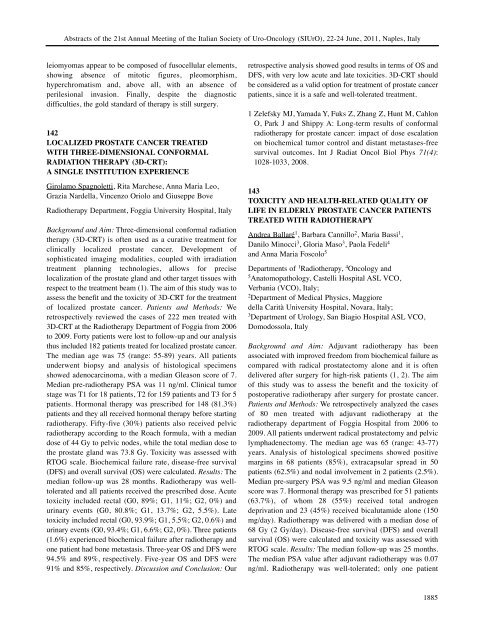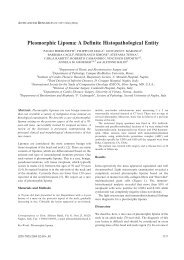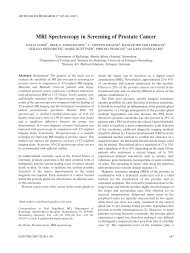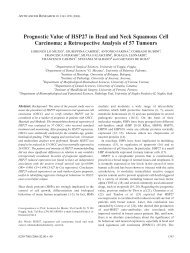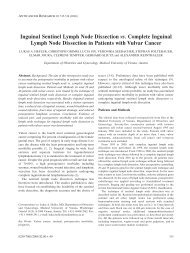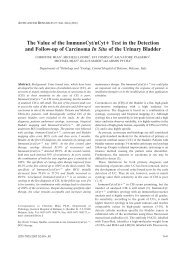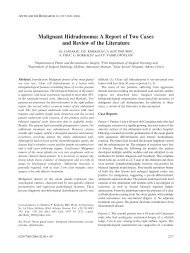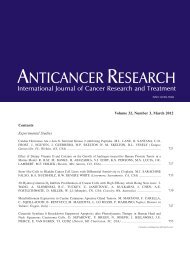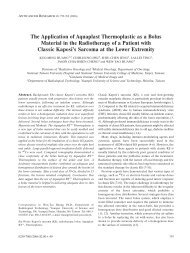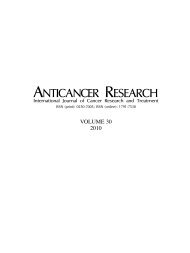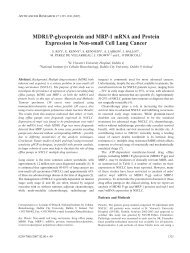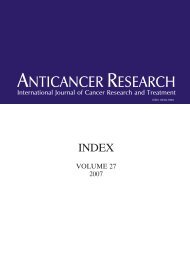ABSTRACTS OF THE 21st ANNUAL MEETING OF THE ITALIAN ...
ABSTRACTS OF THE 21st ANNUAL MEETING OF THE ITALIAN ...
ABSTRACTS OF THE 21st ANNUAL MEETING OF THE ITALIAN ...
Create successful ePaper yourself
Turn your PDF publications into a flip-book with our unique Google optimized e-Paper software.
Abstracts of the <strong>21st</strong> Annual Meeting of the Italian Society of Uro-Oncology (SIUrO), 22-24 June, 2011, Naples, Italy<br />
leiomyomas appear to be composed of fusocellular elements,<br />
showing absence of mitotic figures, pleomorphism,<br />
hyperchromatism and, above all, with an absence of<br />
perilesional invasion. Finally, despite the diagnostic<br />
difficulties, the gold standard of therapy is still surgery.<br />
142<br />
LOCALIZED PROSTATE CANCER TREATED<br />
WITH THREE-DIMENSIONAL CONFORMAL<br />
RADIATION <strong>THE</strong>RAPY (3D-CRT):<br />
A SINGLE INSTITUTION EXPERIENCE<br />
Girolamo Spagnoletti, Rita Marchese, Anna Maria Leo,<br />
Grazia Nardella, Vincenzo Oriolo and Giuseppe Bove<br />
Radiotherapy Department, Foggia University Hospital, Italy<br />
Background and Aim: Three-dimensional conformal radiation<br />
therapy (3D-CRT) is often used as a curative treatment for<br />
clinically localized prostate cancer. Development of<br />
sophisticated imaging modalities, coupled with irradiation<br />
treatment planning technologies, allows for precise<br />
localization of the prostate gland and other target tissues with<br />
respect to the treatment beam (1). The aim of this study was to<br />
assess the benefit and the toxicity of 3D-CRT for the treatment<br />
of localized prostate cancer. Patients and Methods: We<br />
retrospectively reviewed the cases of 222 men treated with<br />
3D-CRT at the Radiotherapy Department of Foggia from 2006<br />
to 2009. Forty patients were lost to follow-up and our analysis<br />
thus included 182 patients treated for localized prostate cancer.<br />
The median age was 75 (range: 55-89) years. All patients<br />
underwent biopsy and analysis of histological specimens<br />
showed adenocarcinoma, with a median Gleason score of 7.<br />
Median pre-radiotherapy PSA was 11 ng/ml. Clinical tumor<br />
stage was T1 for 18 patients, T2 for 159 patients and T3 for 5<br />
patients. Hormonal therapy was prescribed for 148 (81.3%)<br />
patients and they all received hormonal therapy before starting<br />
radiotherapy. Fifty-five (30%) patients also received pelvic<br />
radiotherapy according to the Roach formula, with a median<br />
dose of 44 Gy to pelvic nodes, while the total median dose to<br />
the prostate gland was 73.8 Gy. Toxicity was assessed with<br />
RTOG scale. Biochemical failure rate, disease-free survival<br />
(DFS) and overall survival (OS) were calculated. Results: The<br />
median follow-up was 28 months. Radiotherapy was welltolerated<br />
and all patients received the prescribed dose. Acute<br />
toxicity included rectal (G0, 89%; G1, 11%; G2, 0%) and<br />
urinary events (G0, 80.8%; G1, 13.7%; G2, 5.5%). Late<br />
toxicity included rectal (G0, 93.9%; G1, 5.5%; G2, 0.6%) and<br />
urinary events (G0, 93.4%; G1, 6.6%; G2, 0%). Three patients<br />
(1.6%) experienced biochemical failure after radiotherapy and<br />
one patient had bone metastasis. Three-year OS and DFS were<br />
94.5% and 89%, respectively. Five-year OS and DFS were<br />
91% and 85%, respectively. Discussion and Conclusion: Our<br />
retrospective analysis showed good results in terms of OS and<br />
DFS, with very low acute and late toxicities. 3D-CRT should<br />
be considered as a valid option for treatment of prostate cancer<br />
patients, since it is a safe and well-tolerated treatment.<br />
1 Zelefsky MJ, Yamada Y, Fuks Z, Zhang Z, Hunt M, Cahlon<br />
O, Park J and Shippy A: Long-term results of conformal<br />
radiotherapy for prostate cancer: impact of dose escalation<br />
on biochemical tumor control and distant metastases-free<br />
survival outcomes. Int J Radiat Oncol Biol Phys 71(4):<br />
1028-1033, 2008.<br />
143<br />
TOXICITY AND HEALTH-RELATED QUALITY <strong>OF</strong><br />
LIFE IN ELDERLY PROSTATE CANCER PATIENTS<br />
TREATED WITH RADIO<strong>THE</strong>RAPY<br />
Andrea Ballaré 1 , Barbara Cannillo 2 , Maria Bassi 1 ,<br />
Danilo Minocci 3 , Gloria Maso 3 , Paola Fedeli 4<br />
and Anna Maria Foscolo 5<br />
Departments of 1Radiotherapy, 4Oncology and<br />
5Anatomopathology, Castelli Hospital ASL VCO,<br />
Verbania (VCO), Italy;<br />
2Department of Medical Physics, Maggiore<br />
della Carità University Hospital, Novara, Italy;<br />
3Department of Urology, San Biagio Hospital ASL VCO,<br />
Domodossola, Italy<br />
Background and Aim: Adjuvant radiotherapy has been<br />
associated with improved freedom from biochemical failure as<br />
compared with radical prostatectomy alone and it is often<br />
delivered after surgery for high-risk patients (1, 2). The aim<br />
of this study was to assess the benefit and the toxicity of<br />
postoperative radiotherapy after surgery for prostate cancer.<br />
Patients and Methods: We retrospectively analyzed the cases<br />
of 80 men treated with adjuvant radiotherapy at the<br />
radiotherapy department of Foggia Hospital from 2006 to<br />
2009. All patients underwent radical prostatectomy and pelvic<br />
lymphadenectomy. The median age was 65 (range: 43-77)<br />
years. Analysis of histological specimens showed positive<br />
margins in 68 patients (85%), extracapsular spread in 50<br />
patients (62.5%) and nodal involvement in 2 patients (2.5%).<br />
Median pre-surgery PSA was 9.5 ng/ml and median Gleason<br />
score was 7. Hormonal therapy was prescribed for 51 patients<br />
(63.7%), of whom 28 (55%) received total androgen<br />
deprivation and 23 (45%) received bicalutamide alone (150<br />
mg/day). Radiotherapy was delivered with a median dose of<br />
68 Gy (2 Gy/day). Disease-free survival (DFS) and overall<br />
survival (OS) were calculated and toxicity was assessed with<br />
RTOG scale. Results: The median follow-up was 25 months.<br />
The median PSA value after adjuvant radiotherapy was 0.07<br />
ng/ml. Radiotherapy was well-tolerated; only one patient<br />
1885


